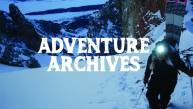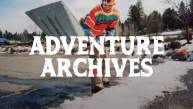
“Duck!” my partner, Ben, told me as he tightened the rope that connected us.
I buried my head into my chest as a waterfall of heavy, cold snow cascaded around me. It collected everywhere there was space: in between my sunglasses, down my jacket, and in my helmet.
"Is this what a river rock feels like as water flows undisturbed by its presence?” I thought to myself as I waited for it to end.My existence on this wall of ice on the final pitch of the Chevy Couloir on the Grand Teton was irrelevant to the snow following gravity to the valley floor.
“Duck again,” Ben said.
More snow. This time, I was ready for the morning shower to be over. I was ready to be at the top. I was ready for my skis to replace my crampons. And I was really, really ready for a slice of pizza at Dornans.
Finally, the sluff let up. The two skiers who had released it while making their first turns off the top of Ford Couloir above us were no longer flushing snow down. I climbed up to Ben, meeting with the rest of our team–Leslie and Tom–and we started up the last leg of the route to the top of the Grand. That’s when it hit me: We were really going to ski this thing.
The Grand Teton is the centerpiece of the Teton range.
Its summit is the highest, its outline piercing the skyline. These days, it sees quite a few winter descents, but until June 15, 1971, the mountain had laid dormant during the snowy season. The descent was thought impossible: the route too dangerous, too exposed, too technical. But one young man, Bill Briggs, thought otherwise. At a time when ski mountaineering was just being born in the United States, Briggs had a bigger belief in what was possible on skis. A bigger belief in what was possible for himself.
On June 15, 1971 Bill Briggs became the first person to ski the Grand Teton, almost 100 years after the first summer summit.
“Skiing the Grand was done to prove what is possible in the sport by way of skiers knowing what they are doing when they are doing it,” Bill wrote to me in an email.
Bill had taken his years of mountain experience, his time spent learning both ski and mountaineering techniques in New Hampshire, Canada, and the Tetons, and translated his preparation into a series of turns down the hanging snowfield of the east face.
Expansiveness. Foreverness. Nowhereness. The white slope of the east face of the Grand looked in one way as if it would go on forever, and in another, like it would abruptly end.
“Look where you are in relation to the planet,” a quote beloved by the TGR Jones boys ran through my head as I clicked into my skis, preparing to depart the summit of the Grand.
Despite the you-fall-you-die run below me, I felt calm, assured, excited. My confidence high knowing the skiing for me, was going to be the easy part. Yes it was steep, but I had skied steep lines around the world. Yes it was committing, but I just needed to commit back.
I was at the intersection of preparation and potential. I was on top of the mountain that had been sitting in my backyard my entire life. The days spent skiing, climbing, training, learning, were becoming actualized in a tangible result. 46 years after Bill Briggs showed to the ski world and himself that skiing the Grand was possible, I was going to follow his tracks.
Anyone who summits the Grand in the winter has achieved something incredible, and what Bill Briggs did [by skiing it first] was a highly remarkable achievement, completely mind-boggling as Exum Guide Zahan Billmoria stated to me as I picked his brain on the past and current skiing culture of Jackson Hole’s Teton range. His definitiveness of his opinion made me stop and think for a moment: Bill skiing the Grand on old school wooden planks in the '70s–when ski mountaineering was barely on the map in the US–that was remarkable. But skiing the Grand today, with high-tech equipment and endless beta on the internet ... was that really incredible?

"Wow, have you really become that jaded?" I thought to myself. Of course it is.
Sure I've had longer days in the mountains, or skied lines that felt steeper or more consequential. But skiing the Grand is a big deal. It is a long approach, has technical ice pitches, is dangerous in its configuration where you’re prone to the sluff from anyone above you, and the consequence of a fall is serious. Maybe because the Grand had sat in my backyard my entire life. Maybe because social media inundates us with daily reminders of people getting rad. But whatever the case, Zahan reminded me a year later after my own summit, that painting turns down the highest peak of the Tetons was a special feat, that should be celebrated.
When I asked Bill, a year after I skied the Grand, how he felt about the increase in popularity of skiing in the Tetons, he replied with joy and enthusiasm.
“Wonderful isn’t it?” he said.
As we talked, it seemed to me that what Bill really wanted to convey was that people are more capable than they think. The ever-happy Briggs (right) can still be found picking his banjo at The Stagecoach Bar in Wilson Wyoming. Jonathan Adams/Jackson Hole News & Guide photo.
"My firm belief is that if something can be in any way sensed it can be fully known and its mystery fully solved," he said.
By skiing the Grand, Bill eclipsed people’s preconceived notions of his and their own potential. Everything is knowable. Now when you look at the tracks that cover the Teton range, you see GS turns replacing hop turns. Lines drawn in the snow down slopes that ten years ago hadn’t been done. The gear is new, the techniques are new, but the curiosity remains the same.
And it’s all thanks to Bill.
Editor's note: Perhaps the singular most endearing quality of Briggs is his eternal gratitude and humility, as exemplified by a simple response in our initial email conversation with him. When asked whether he would be up to speaking with us for the story, Briggs responded simply, "Am I really historical?"











RMa1959
March 26th, 2018
You are so amazing and brave!